
Chris Parker and I left the Best Western Rama Inn in Oakdale just after 7:30 AM and drove over to the Sierra Railroad shops where we found the two steam engines that would be pulling our special steam train today, McCloud River 2-8-2 18 and Sierra Railroad 2-8-0 28. This was a Pacific Locomotive Association excursion with Henry Luna as the organizer.

Both engines in the fantastic morning light.



McCloud River Railroad 2-8-2 18 built by Baldwin Locomotive Works in 1914. The Panama Pacific Exposition held in San Francisco in 1915 celebrated the completion of the Panama Canal. The exposition was heavy on symbolism of connecting East and West. The organizers also wanted all major industries of California prominently featured, and to that end the two McCloud River companies joined forces with the neighboring Weed and Red River lumber companies to build an exhibit featuring the northeastern California pine lumber sector. Centerpiece of the exhibit was a house built entirely out of the products of the three sawmills or other products from the region, including a fireplace constructed from volcanic rocks.
The McCloud River Railroad assembled a display train consisting of two newly completed flatcars loaded with prime examples of the finest old growth sugar pines the McCloud woods could grow, a new boxcar loaded with lumber produced by the McCloud mill and a caboose specially constructed in the railroad's shops for the event. To "power" the display train the railroad turned to Baldwin, which at the time had a partially completed 90-ton Mikado on its factory floor. The Caddo River Lumber Company of Arkansas originally ordered the locomotive as their second 3, but their financing package fell apart shortly after Baldwin started construction. The McCloud River Railroad assumed the order as their 18 and Baldwin applied a special "Exposition Finish" to the locomotive upon its completion in November 1914. Baldwin shipped the steam engine to San Francisco, where it joined the other cars sent south from McCloud. The completed train set remained on display throughout 1915 and 18 finally reached home rails in January 1916 after the exposition closed.
It settled down to a long career of hauling logs and lumber over the McCloud River Railroad. A couple tender swaps and some modernization work detailed elsewhere on this site modified its appearance but kept it in top shape. The 18 ended up being one of three Mikados the railroad retained as backup power after dieselizing all mainline operations in 1953, though it apparently saw little if any service. In 1956 the neighboring Yreka Western bought the 18, where it rejoined the former McCloud River 19. The two Mikados powered the small road, including increasingly frequent railfan excursions, through the rest of the 1950's and into the 1960's.
18's operating days came to an abrupt end in 1964 when it blew a cylinder head while powering a railfan excursion. The YW lacked the money or shop to effect repairs and it would spend the next thirty-four years stored in the Yreka yards, usually partially to entirely covered with a tarp. YW's corporate parent, Kyle Railways, talked from time to time of restoring 18 and sending it off to one of their other tourist railroads, but never acted on those plans. In 1998, Kyle Railways decided to sell the Yreka Western, but decided to sell the 18 separate from the railroad. The McCloud Railway Company beat out at least two other bidders at the auction and it returned to McCloud in March 1998.
Newspaper reports indicated McCloud Railway paid $80,000 for the 18, then invested another $350,000 over the next three years restoring it to service. It steamed again for the first time since 1964 when it powered a trip with the 25 in February 2001, after which time it replaced the smaller locomotive in the steam program. The locomotive operated several times throughout the early 2000's, but growing financial problems forced the McCloud Railway to place the 18 up for sale in 2004. The railroad ran several announced "last runs" between the fall of 2004 and the summer of 2005, with the last of the last finally happening on Sunday, 7 August 2005.
The Nevada Commission for the Reconstruction of the V&T Railway bought 18 in January 2005 for eventual use on the part of the fabeled Virginia & Truckee they were in the process of rebuilding in western Nevada. The Commission leased the steam engine to the Sierra Northern Railroad and in April 2007, they loaded it onto a truck for shipment south.

Headlight and builder's plate.

Sierra Railway 2-8-0 28 built by Baldwin in 1922. It was ordered to haul heavy freight and in the 1930's, also transported materials to the Hetch Hetchy dam site. After completion of the project, 28 returned to hauling freight. After dieselisation in 1955, it went into storage at the Jamestown roundhouse, occasionally steamed up for filming and excursions. It was derailed on an excursion in 1963 and retired with damaged air brakes. Repaired by 1971 for the opening of Railtown 1897, it then regularly pulled the "Motherlode Cannonball" excursion from Jamestown to Fassler. It also appeared in several films and in 1999, moved to Old Sacramento to participate in Raifair '99.

Headlight and builder's plate. We eturned towards the boarding area for today's trip.

An overview of the Sierra Railroad Golden Sunset Dinner Train and new boarding area. We parked on the street so exiting at the end of the day would be easy. At this point, I had decided to ride home with Chris and forgo the Amtrak mileage and long overnight bus ride so it would be interesting to see what time we arrived home in Santa Ana tonight; the Thruway Bus from San Joaquin Train 704 was scheduled to arrive at 1:40 AM.
Our train would be boarding at the old Sierra Railroad Dinner Train station, now a Mexican restaurant and just before 9:00 AM, our special steam train reversed into the loading area. First, the lounge supplies would be loaded before being spotted for boarding. I was at the perfect place and the first person to board, walking all the way to the rear partial open air coach, choosing the rear seat with Chris across the aisle. It was announced that our first photo runby would be at the grade crossing south of our train so the two of us detrained and walked to the crossing.
Today's consist was McCloud 18 and Sierra 28, coaches 12, 14 and 15, open air concession car 697 and partial open air car 599.

Our train at Oakdale ready to start our day of photography and train-riding. I walked down and joined the photo line to wait for the first photo runby.







Photo runby one, after which all reboarded and departed, passing many of the photographers who would be chasing our double-headed steam train. Once we left the last grade crossing, we made our way out to along an orchard where the next photo runby would occur.

Reverse move one.




Photo runby two.
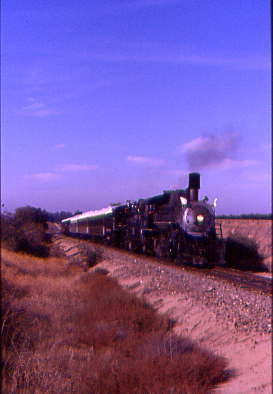
Reverse move two.




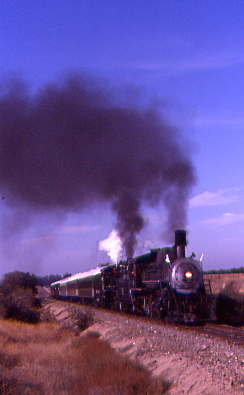

Photo runby three. After it was over, we reboarded and continued east.

Our train only travelled through the next curve and out onto the straight track, passing through a five-mile-an-hour slow order before stopping for the next photo runby.

Reverse move three.

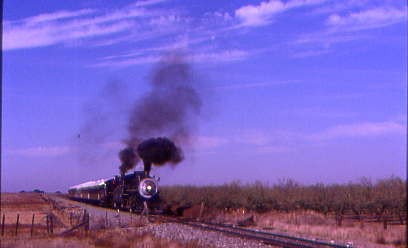

Photo runby four. The slow order did have an effect on the engine's performance.

Reverse move four.




Photo runby five. Everyone reboarded and our next stop was to be Warnersville, where the engines would be serviced.



Rounding the curves toward the Dodge City Curves.

The curve on the way to the turkey farms.

Four horses were watching our twin iron horses.

A few minutes later, we passed the turkey farms as thoughts of a Thanksgiving dinner raced in my head.


Rounding the last curve into Warnersville where we were allowed off.

Sierra Railroad 28 being serviced.



McCloud 18 having the same treatment.

The front of McCloud River Railroad 18.

The rear of our steam special.


The marker lights on coach 599.
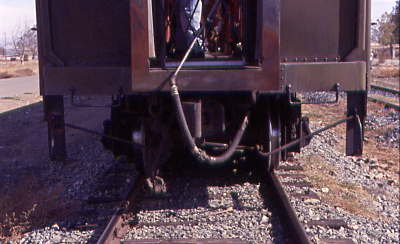
The coupler of our rear car. I returned on board to finish my lunch and found that the local flies had taken over the inside then changed film and went back outside.

The top of Sierra 28's tender.

The light on Sierra 28.

A pre-departure picture at Warnersville.

We rounded a curve to cross the next creek as we travelled along a road with the chasers still with us.

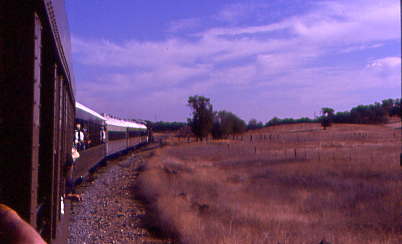
We arrived in Coopersville, the destination for our excursion.